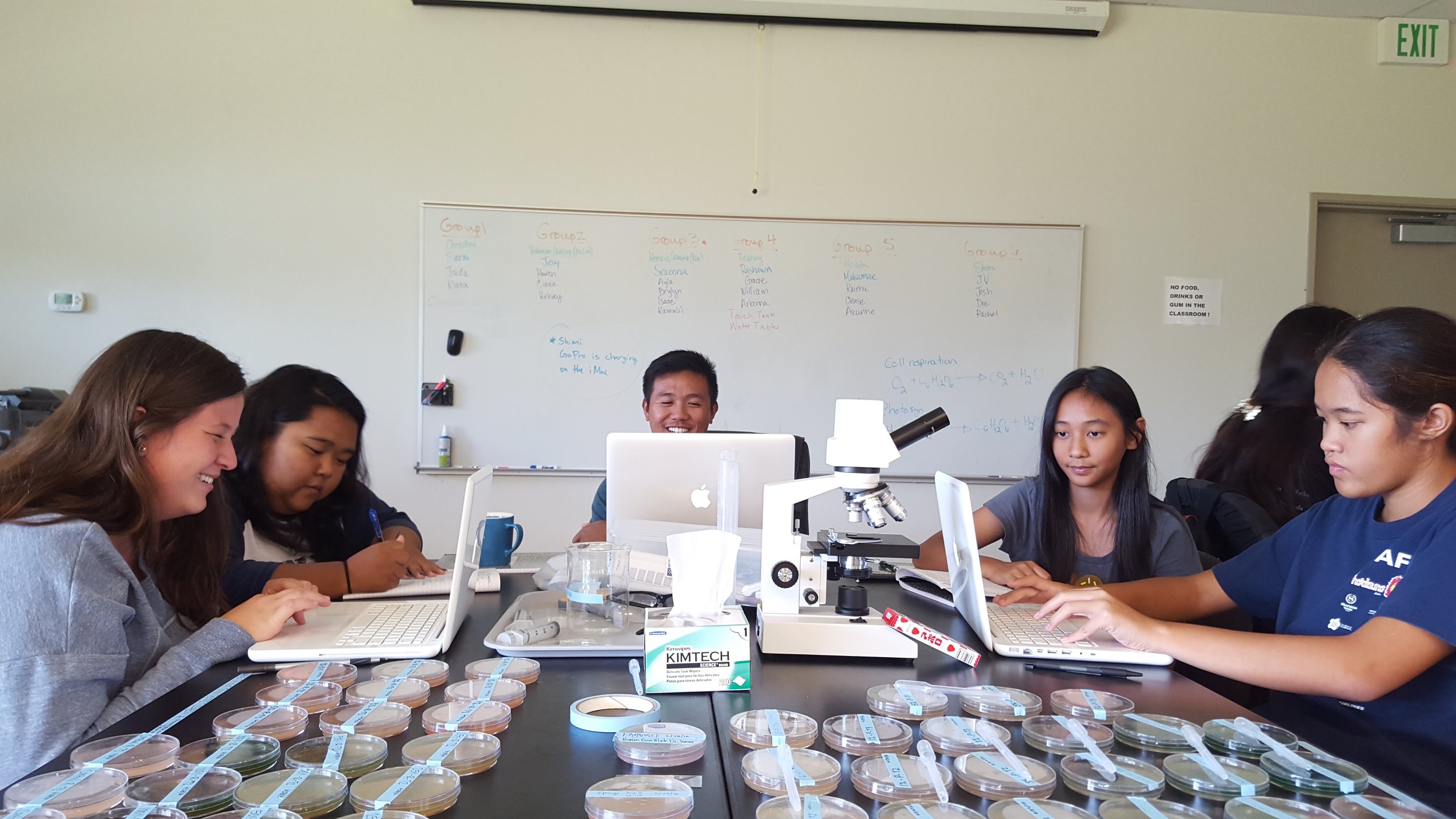
Science Inquiry Experiences
-
The KeaoaLoʻe REMS Lab has several place-based lab fieldtrips designed for high school science classes and groups. They are also appropriate for early undergraduates and non-science majors.
Students work in teams to develop and test their own hypotheses on one of the following topics:
▶ Coral Feeding and Microplastics - measuring the abundance and diversity of microplastics in marine ecosystems and examining how this pollution is impacting coral behavior and survival (offered year round). Limited to 24 students per visit (please inquire about larger classes).
▶ Marine Bioacoustics - using hydrophones to record and analyze the sounds of invertebrate interactions (offered year round). Limited to 36 students per visit.
▶ Ocean Acidification - using coral skeletons and manipulating seawater pH with carbon dioxide gas to measure the effects on water hardness and calcium carbonate dissolution (offered year round). Limited to 36 students per visit.
▶ Marine Biodiversity - using Autonomous Reef Monitoring Structures (ARMS) to record and calculate the biodiversity of the coral reef cryptofauna community in different environments (offered year round). Limited to 24 students per visit (please inquire about larger classes).
▶ Marine Neuroethology - using marine invertebrates to produce ethograms and examine the mechanics of animal behavior (seasonal, please check availability). Limited to 24 students per visit.
▶ Sea Urchin Fertilization - using collector urchins to test the effects of water quality on fertilization success and embryonic development (seasonal, please check availability). Limited to 36 students per visit.
▶ Coral Growth and Survival - using coral settlement tiles to examine and record how different environments influence the growth of coral colonies (inquire for availability). Limited to 24 students per visit (please inquire about larger classes).
▶ Confocal Microscopy - visualizing physiological processes in coral systems using 3D, real-time fluorescence imaging (inquire for availability). Limited to 12 students per visit (please inquire about larger classes).
Each lab is comprised of two sections:
▶ Part I: A field trip to HIMB where students will conduct their own experiments in the Marine Science Research Learning Center.
▶ Part II: Data analysis and scientific communication in the form of discussion and presentations or reports done in the home classroom or as homework after the field trip.
To arrange a science inquiry fieldtrip, teachers/educators click on the “INQUIRE TODAY” button below.
-
Next Generation Science Standards - The HIMB Science Inquiry Lab Fieldtrips are designed to explore the following scientific practices, disciplinary core ideas, and cross-cutting concepts emphasized in the Next Generation Science Standards (NGSS). Standards specific to each module are included in the appendix at the end of each lesson PDF
Science and Engineering Practices (All modules)
1. Asking Questions and Defining Problems
2. Scientific Knowledge is Open to Revision in Light of New Evidence
3. Engaging in Argument from Evidence
4. Planning and Carrying Out Investigations
5. Scientific Investigations Use a Variety of Methods
6. Analyzing and Interpreting Data
7. Obtaining, Evaluating, and Communicating Information
Crosscutting Concepts (All modules)
1. Stability and Change
2. Cause and Effect
3. Patterns
Disciplinary Core Ideas
1. LS1.A: Structure and Function (Sea Urchin fertilization; Marine Neuroethology)
2. LS1.B: Growth and Development of Organisms (Sea Urchin Fertilization)
3. LS2.C: Ecosystem Dynamics, Functioning, and Resilience (Marine Biodiversity; Coral Growth and Survival; Ocean Acidification)
4. LS2.D: Social Interactions and Group Behavior (Marine Bioacoustics; Marine Neuroethology; Sea Urchin Fertilization)
5. LS4.C: Adaptation (Marine Neuroethology; Marine Biodiversity; Ocean Acidification)
6. LS4.D: Biodiversity and Humans (Marine Biodiversity; Ocean Acidification; Sea Urchin Fertilization)
7. HS-LS1-4 From Molecules to Organisms: Structures and Processes (Sea Urchin Fertilization)
8. HS-LS2-6 Ecosystems: Interactions, Energy, and Dynamics (ecological interactions) (Marine Biodivsersity; Ocean Acidification; Coral Growth and Survival)
9. HS-LS2-7 Ecosystems: Interactions, Energy, and Dynamics (human impacts) (All modules)
10. HS-LS2-8 Ecosystems: Interactions, Energy, and Dynamics (group behavior) (Marine Neuroethology; Sea Urchin Fertilization; Coral Growth and Survival)
Common Core State Standards Connections (All modules):
ELA/Literacy
1. SL.11-12.5 a. Make strategic use of digital media (e.g., textual, graphical, audio, visual, and interactive elements) in presentations to enhance understanding of findings, reasoning, and evidence and to add interest. (HS-LS1-4)
2. RST.11-12.1 a. Cite specific textual evidence to support analysis of science and technical texts, attending to important distinctions the author makes and to any gaps or inconsistencies in the account. (HS-LS2-2)
3. RST.11-12.7 a. Integrate and evaluate multiple sources of information presented in diverse formats and media (e.g., quantitative data, video, multimedia) in order to address a question or solve a problem. (HS-LS2-6)
4. WHST.9-12.7 a. Conduct short as well as more sustained research projects to answer a question (including a self-generated question) or solve a problem; narrow or broaden the inquiry when appropriate; synthesize multiple sources on the subject, demonstrating understanding of the subject under investigation. (HS-LS2-7)
5. WHST.9-12.9 a. Draw evidence from informational texts to support analysis, reflection, and research. (HS-LS4-4)
6. WHST.9-12.2 a. Write informative/explanatory texts, including the narration of historical events, scientific procedures/ experiments, or technical processes. (HS-LS2-2)
Mathematics
7. MP.2 a. Reason abstractly and quantitatively. (HS-LS2-2)
8. HSN.Q.A.3 a. Choose a level of accuracy appropriate to limitations on measurement when reporting quantities. (HS-LS2-2)
-
Is there transportation support to and from our school?
The HI DOE has recently implemented the EXPRESS program to assist high school student transportation to and from school and educational experiences. Please check out the EXPRESS website for more information!
Are there tours of HIMB or hands-on activities for upper elementary and middle school classes?
If you are interested in tours of HIMB or hands-on activities for upper elementary and middle school classes, contact the HIMB Center for Community Education.
Are there internship options available for those who are not in high school, recent undergraduate, or lower division undergrad student?
Unfortunately we are not able to host high school internships through this program.
If you are an Undergraduate at UH, visit the HIMB Undergraduate Research Opportunities page or the the UH Mānoa Undergraduate Research Opportunities Program for additional internship possibilities.